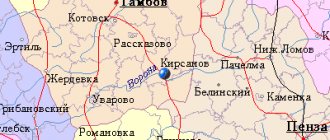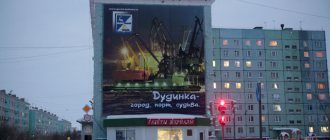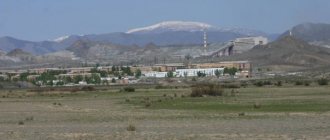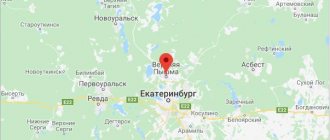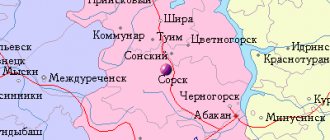This term has other meanings, see Krasnoznamensk.
| City Krasnoznamensk Flag | Coat of arms |
| A country | Russia, Russia |
| Subject of the federation | Kaliningrad regionKaliningrad region |
| Urban district | Krasnoznamensky |
| Coordinates | 54°57′00″ n. w. 22°30′00″ E. d. / 54.95000° n. w. 22.50000° E. d. / 54.95000; 22.50000 (G) [www.openstreetmap.org/?mlat=54.95000&mlon=22.50000&zoom=12 (O)] (Z)Coordinates: 54°57′00″ N. w. 22°30′00″ E. d. / 54.95000° n. w. 22.50000° E. d. / 54.95000; 22.50000 (G) [www.openstreetmap.org/?mlat=54.95000&mlon=22.50000&zoom=12 (O)] (I) |
| Based | 1576 |
| Former names | until 1734 - Lazdinai until 1938 - |
| City with | 1946 |
| Square | 8 km² |
| Center height | 30 |
| Population | ↘3282[1] people (2016) |
| Density | 410.25 people/km² |
| National composition | Russians |
| Timezone | UTC+2 |
| Telephone code | +7 40164 |
| Postcode | 238730 |
| Vehicle code | 39, 91 |
| OKATO code | [classif.spb.ru/classificators/view/okt.php?st=A&kr=1&kod=27218501 27 218 501] |
| Krasnoznamensk Moscow |
| Kaliningrad Krasnoznamensk |
Audio, photo and video
on Wikimedia Commons
K: Settlements founded in 1576
Krasnoznamensk
(until 1938 -
Lazdenen
, German
Lasdehnen
, lit. Lazdynai, Polish
Łoździenie
; until 1946 -
Haselberg
, German
Haselberg
) - a city in the Kaliningrad region of Russia, the administrative center of the Krasnoznamensky urban district, and until January 1, 2021, the abolished Krasnoznamensky city settlements.
Architecture and landmarks
The city is built up mainly with one- or two-story German houses. The modern residential area is located on the high left bank. The industrial zone is located in the southern part of the city[2].
- Church (XIX century)
In the Krasnoznamensky district there are 17 objects classified as historical and cultural monuments, 4 archaeological monuments, 4 mass graves of soldiers who died in the Great Patriotic War, and a memorial complex dedicated to F. S. Antipenkov.
Kirch Stüler
Having passed through the bridge, the main attraction of Krasnoznamensk opens up - a 40-meter high church, built in 1875 according to the design of Friedrich August Stüler, one of the most significant architects of European classicism and historicism.
August Stüler
Stüler created his creations in many cities and made a significant contribution to European architecture of that time. A beautiful temple was erected instead of a destroyed church built in 1578. A masterpiece of religious architecture, it is a three-nave brick basilica with a tower, a polygonal choir and stepped pediments.
After the war, the former evangelical church housed a garage and various warehouses. In 1991, the church became the property of the Russian Orthodox Church. Nowadays, it houses the Orthodox Church of the Apostles Peter and Paul of the Chernyakhov diocese of the Russian Orthodox Church.
Notes
- ↑ 12
www.gks.ru/free_doc/doc_2016/bul_dr/mun_obr2016.rar Population of the Russian Federation by municipalities as of January 1, 2021 - ↑ 12
[www.mojgorod.ru/kalining_obl/krasnoznams/ Krasnoznamensk in the people's encyclopedia “My City”] - [demoscope.ru/weekly/ssp/rus59_reg2.php All-Union Population Census of 1959. The size of the urban population of the RSFSR, its territorial units, urban settlements and urban areas by gender] (Russian). Demoscope Weekly. Retrieved September 25, 2013. [www.webcitation.org/6GDOghWC9 Archived from the original on April 28, 2013].
- [demoscope.ru/weekly/ssp/rus70_reg2.php All-Union Population Census of 1970 The size of the urban population of the RSFSR, its territorial units, urban settlements and urban areas by gender.] (Russian). Demoscope Weekly. Retrieved September 25, 2013. [www.webcitation.org/6GDOiMstp Archived from the original on April 28, 2013].
- [demoscope.ru/weekly/ssp/rus79_reg2.php All-Union Population Census of 1979 The size of the urban population of the RSFSR, its territorial units, urban settlements and urban areas by gender.] (Russian). Demoscope Weekly. Retrieved September 25, 2013. [www.webcitation.org/6GDOjhZ5L Archived from the original on April 28, 2013].
- [demoscope.ru/weekly/ssp/rus89_reg2.php All-Union Population Census of 1989. Urban population]. [www.webcitation.org/617x0o0Pa Archived from the original on August 22, 2011].
- ↑ 123456789
www.MojGorod.ru/kalining_obl/krasnoznams/index.html People's encyclopedia “My City”. Krasnoznamensk (Kaliningrad region) - [kaliningrad.gks.ru/wps/wcm/connect/rosstat_ts/kaliningrad/resources/67d5be0041e7f6558d13cd2d59c15b71/Number+and+location+of population.xls All-Russian Population Census 2002. Kaliningrad region. Number and distribution of population]. Retrieved February 3, 2014. [www.webcitation.org/6N6rTsRQJ Archived from the original on February 3, 2014].
- [www.gks.ru/bgd/regl/B09_109/IssWWW.exe/Stg/d01/tabl-21-09.xls Number of permanent population of the Russian Federation by cities, urban-type settlements and districts as of January 1, 2009]. Retrieved January 2, 2014. [www.webcitation.org/6MJmu0z1u Archived from the original on January 2, 2014].
- [kaliningrad.gks.ru/wps/wcm/connect/rosstat_ts/kaliningrad/resources/e9a049804e9f624b9e6e9f8e65563e6a/Results+All-Russian Population Census 2010_vol.1.xlsx All-Union Population Census 2010. Kaliningrad region. Table 10. Population of urban districts, municipal districts, urban and rural settlements, urban settlements, rural settlements]. Retrieved November 28, 2013. [www.webcitation.org/6LTFYTQqP Archived from the original on 2013-11-228].
- [www.gks.ru/free_doc/doc_2012/bul_dr/mun_obr2012.rar Population of the Russian Federation by municipalities. Table 35. Estimated resident population as of January 1, 2012]. Retrieved May 31, 2014. [www.webcitation.org/6PyOWbdMc Archived from the original on May 31, 2014].
- [www.gks.ru/free_doc/doc_2013/bul_dr/mun_obr2013.rar Population of the Russian Federation by municipalities as of January 1, 2013. - M.: Federal State Statistics Service Rosstat, 2013. - 528 p. (Table 33. Population of urban districts, municipal districts, urban and rural settlements, urban settlements, rural settlements)]. Retrieved November 16, 2013. [www.webcitation.org/6LAdCWSxH Archived from the original on November 16, 2013].
- [www.gks.ru/free_doc/doc_2014/bul_dr/mun_obr2014.rar Table 33. Population of the Russian Federation by municipalities as of January 1, 2014]. Retrieved August 2, 2014. [www.webcitation.org/6RWqP50QK Archived from the original on August 2, 2014].
- [www.gks.ru/free_doc/doc_2015/bul_dr/mun_obr2015.rar Population of the Russian Federation by municipalities as of January 1, 2015]. Retrieved August 6, 2015. [www.webcitation.org/6aaNzOlFO Archived from the original on August 6, 2015].
- taking into account the cities of Crimea
- [www.gks.ru/free_doc/doc_2016/bul_dr/mun_obr2016.rar Population of the Russian Federation by municipalities as of January 1, 2021. Table “31. Population of cities and towns by federal districts and constituent entities of the Russian Federation as of January 1, 2021.” RAR archive (1.0 MB)]
- [kaliningrad.gks.ru/wps/wcm/connect/rosstat_ts/kaliningrad/ru/census_and_researching/census/national_census_2010/score_2010/ Results:: Kaliningradstat]
- ↑ 12
[www.b-kld.ru/catalog/?company=58988 Business Kaliningrad] - ↑ 12
[www.mycicerone.ru/wiki/Krasnoznamensk Krasnoznamensk on MyCicerone.ru]
An excerpt characterizing Krasnoznamensk (Kaliningrad region)
On September 8th, a very important officer entered the barn to see the prisoners, judging by the respect with which the guards treated him. This officer, probably a staff officer, with a list in his hands, made a roll call of all the Russians, naming Pierre: celui qui n'avoue pas son nom [the one who does not say his name]. And, looking indifferently and lazily at all the prisoners, he ordered the guard officer to dress them decently and tidy them up before leading them to the marshal. An hour later, a company of soldiers arrived, and Pierre and thirteen others were taken to the Maiden Field. The day was clear, sunny after the rain, and the air was unusually clean. Smoke did not settle down like on the day when Pierre was taken out of the guardhouse at Zubovsky Val; smoke rose in columns in the clear air. The flames of the fires were nowhere to be seen, but columns of smoke rose from all sides, and all of Moscow, everything that Pierre could see, was one conflagration. On all sides one could see vacant lots with stoves and chimneys and occasionally the charred walls of stone houses. Pierre looked closely at the fires and did not recognize familiar quarters of the city. In some places, surviving churches could be seen. The Kremlin, undestroyed, loomed white from afar with its towers and Ivan the Great. Nearby, the dome of the Novodevichy Convent glittered merrily, and the bell of the Gospel was especially loudly heard from there. This announcement reminded Pierre that it was Sunday and the feast of the Nativity of the Virgin Mary. But it seemed that there was no one to celebrate this holiday: everywhere there was devastation from the fire, and from the Russian people there were only occasionally ragged, frightened people who hid at the sight of the French. Obviously, the Russian nest was ravaged and destroyed; but behind the destruction of this Russian order of life, Pierre unconsciously felt that over this ruined nest his own, completely different, but firm French order had been established. He felt this from the sight of those soldiers walking cheerfully and cheerfully, in regular rows, who escorted him with other criminals; he felt this from the sight of some important French official in a double carriage, driven by a soldier, driving towards him. He felt this from the cheerful sounds of regimental music coming from the left side of the field, and especially he felt and understood it from the list that the visiting French officer read this morning, calling out the prisoners. Pierre was taken by some soldiers, taken to one place or another with dozens of other people; it seemed that they could forget about him, mix him up with others. But no: his answers given during the interrogation came back to him in the form of his name: celui qui n'avoue pas son nom. And under this name, which Pierre was afraid of, he was now being led somewhere, with undoubted confidence written on their faces that all the other prisoners and he were the ones who were needed, and that they were being taken where they were needed. Pierre felt like an insignificant sliver caught in the wheels of a machine unknown to him, but functioning correctly. Pierre and other criminals were led to the right side of the Maiden's Field, not far from the monastery, to a large white house with a huge garden. This was the house of Prince Shcherbatov, in which Pierre had often visited the owner before and in which now, as he learned from the conversation of the soldiers, the marshal, the Duke of Eckmuhl, was stationed. They were led to the porch and one by one they were led into the house. Pierre was brought in sixth. Through a glass gallery, a vestibule, and an antechamber, familiar to Pierre, he was led into a long, low office, at the door of which stood an adjutant. Davout sat at the end of the room above the table, glasses on his nose. Pierre came close to him. Davout, without raising his eyes, was apparently coping with some paper lying in front of him. Without raising his eyes, he quietly asked: “Qui etes vous?” [Who are you?] Pierre was silent because he was unable to utter words. For Pierre, Davout was not just a French general; for Pierre Davout, he was a man known for his cruelty. Looking at the cold face of Davout, who, like a strict teacher, agreed to have patience for the time being and wait for an answer, Pierre felt that every second of delay could cost him his life; but he didn't know what to say. He did not dare say what he said during the first interrogation; revealing one's rank and position was both dangerous and shameful. Pierre was silent. But before Pierre could decide on anything, Davout raised his head, raised his glasses to his forehead, narrowed his eyes and looked intently at Pierre. “I know this man,” he said in a measured, cold voice, obviously calculated to frighten Pierre. The cold that had previously run down Pierre's back gripped his head like a vice. – Mon general, vous ne pouvez pas me connaitre, je ne vous ai jamais vu... [You couldn’t know me, general, I’ve never seen you.] – C’est un espion russe, [This is a Russian spy] – interrupted his Davout, addressing another general who was in the room and whom Pierre did not notice. And Davout turned away. With an unexpected boom in his voice, Pierre suddenly spoke quickly. “Non, Monseigneur,” he said, suddenly remembering that Davout was a Duke. - Non, Monseigneur, vous n'avez pas pu me connaitre. Je suis un officier militia naire et je n'ai pas quitte Moscou. [No, Your Highness... No, Your Highness, you could not know me. I am a police officer, and I have not left Moscow.] – Votre nom? [Your name?] - repeated Davout.
Projectile in the bell tower
If you look at the top of the structure, you can see a Russian shell sticking out in the corner of the southeast part of the tower. He ended up there during the First World War.
After the ammunition hit the church and did not explode, local residents picked it up from the ground, deactivated it and installed it in the bell tower.
Since then, the shell has stuck out in the bell tower of the church, as a reminder of the troubles that the town and the church had to endure during the bloody wars.
Previously, kaskad.tv wrote about what to see during a trip to Neman.
